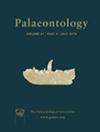Fluorescent colour patterns in the basal pectinid Pleuronectites from the Middle Triassic of Central Europe: origin, fate and taxonomic implications of fluorescence
IF 2.3
2区 地球科学
Q1 PALEONTOLOGY
引用次数: 1
Abstract
UV light‐induced fluorescence is widely used as a key to reveal residual shell colour patterns of Neogene and Palaeogene molluscs. However, only few examples of fluorescent colour patterns are known from Mesozoic marine shells and little is known about the nature of fluorescence in fossils. Here, UV light‐induced fluorescence reveals previously unseen abundance and diversity in the colour patterns of the basal pectinid Pleuronectites laevigatus from the Middle Triassic Muschelkalk of Central Europe. In addition to known variations of radial bands, a multitude of zigzag and zigzag‐related patterns was found. The diversity of colour patterns is comparable to modern pectinids and is interpreted as colour pattern polymorphism. Raman spectra of the colour patterns indicated the preservation of residual organic pigments with aromatic moieties. The fluorescence properties of P. laevigatus and other basal pectinids from the Muschelkalk of Germany and France are described in detail, suggesting that colour pattern fluorescence is due to colourless diagenetic products of the pigments, not to the fossil pigments themselves. A remarkable feature of the colour patterns of P. laevigatus is the presence of different fluorescence colours. Because a gradual shift of the fluorescence colour from yellow to red with decreasing intensity to finally non‐fluorescent is observed, which correlates with the provenance of the specimens, the fluorescence properties are interpreted to reflect differences in diagenetic history. The results show that the fluorescence colour of fossil molluscs, especially of Mesozoic molluscs, may be affected by diagenesis and should only be used with caution for taxonomic purposes.中欧中三叠世基底梳状胸膜的荧光颜色模式:荧光的起源、命运和分类学意义
紫外光诱导荧光作为揭示新近系和古近系软体动物残壳颜色模式的关键,被广泛应用。然而,从中生代海洋贝壳中发现的荧光颜色模式很少,对化石中荧光的性质也知之甚少。在这里,紫外线诱导的荧光揭示了来自中欧中三叠世Muschelkalk的基础果胶类Pleuronectites laevigatus颜色模式的丰富性和多样性。除了已知的径向带变化外,还发现了许多之字形和与之字形相关的图案。颜色图案的多样性可与现代果胶相媲美,并被解释为颜色图案的多态性。颜色模式的拉曼光谱表明保留了含有芳香部分的残留有机色素。本文详细描述了P. laevigatus和其他来自德国和法国Muschelkalk的基生果胶的荧光特性,表明彩色模式荧光是由于色素的无色成岩产物,而不是化石色素本身。P. laevigatus颜色模式的一个显著特征是存在不同的荧光颜色。由于观察到荧光颜色从黄色逐渐转变为红色,并随着强度的降低而最终变为非荧光,这与标本的来源有关,因此荧光特性被解释为反映了成岩历史的差异。结果表明,化石软体动物,特别是中生代软体动物的荧光颜色可能受到成岩作用的影响,仅用于分类目的时应谨慎使用。
本文章由计算机程序翻译,如有差异,请以英文原文为准。
求助全文
约1分钟内获得全文
求助全文
来源期刊

Palaeontology
地学-古生物学
CiteScore
5.60
自引率
3.80%
发文量
43
审稿时长
6 months
期刊介绍:
Palaeontology publishes a wide variety of papers on palaeontological topics covering:
palaeozoology
palaeobotany
systematic studies
palaeoecology
micropalaeontology
palaeobiogeography
functional morphology
stratigraphy
taxonomy
taphonomy
palaeoenvironmental reconstruction
palaeoclimate analysis and biomineralization studies.
 求助内容:
求助内容: 应助结果提醒方式:
应助结果提醒方式:


